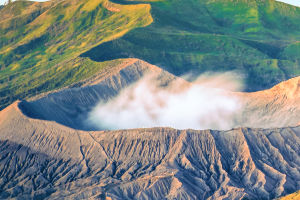Valleys are unique landforms that offer a glimpse into the wonders of nature. These low-lying lands, situated between hills or mountains, are characterized by a series of rivers or lakes that support diverse flora and fauna.
Valleys are shaped by a combination of internal and external dynamics of the earth, making them a fascinating geomorphic phenomenon.
During the mountain-building process, the earth's crust undergoes internal forces such as crustal movement that result in high and low folds and faults. External forces such as differential weathering and river erosion then contribute to the formation of high ridges and wide valleys.
Over time, the interplay of these forces creates the breathtaking natural landscapes that we see today.
One of the most stunning valleys in the world is the Ten Peaks Valley located in Banff National Park in western Alberta, Canada. This valley is home to ten snow-capped mountains, which are reflected in the blue mirror-like surface of Lake Monroe. At over 3,424 meters high, the Delta Mountains are the tallest of the ten giants.
The valley floor is teeming with a dense forest that provides a home for many small animals, making it a haven for wildlife enthusiasts.
Yosemite Valley is another famous valley that stretches for about 7.5 miles and is located in the Sierra Nevada Mountains of Central California. This valley was formed by glaciers about 30 million years ago and is famous for its steep granite cliffs that attract rock climbers from all over the world.
El Capitan, which rises nearly a kilometre from the ground, is a popular challenge for these daredevils.
Visitors can also enjoy hiking trails that offer panoramic views of dense forests and green meadows. Yosemite Valley is also home to several waterfalls, including the highest waterfall in North America, Yosemite Falls.
Kalalau Valley is a natural haven located on the island of Kaua'i, Hawaii. Surrounded by cliffs over 610 meters high, it can only be accessed by foot, kayak, or helicopter and is often referred to as Kaua'i Cathedral. It boasts a unique blend of sunshine and frequent rainfall that creates a bustling paradise.
The valley is home to various plants that grow on cliffs, while fauna thrives in the surrounding forests and mountains. Visitors can also enjoy the stunning waterfall that feeds into the valley, where mangoes, passion fruits, and cherries grow in abundance.
Valleys not only offer stunning natural landscapes but also serve as essential ecosystems for various plant and animal species. Many valleys are home to unique species that are adapted to the specific environmental conditions found in these areas.
For example, the Ten Peaks Valley in Canada is home to grizzly bears, elk, and beavers, while Yosemite Valley is home to black bears, bobcats, and coyotes. These valleys also play a critical role in regulating the water cycle, providing a source of fresh water for downstream communities.
Therefore, it is essential to protect these valuable natural resources and ensure that they continue to thrive for future generations to enjoy.
In conclusion, valleys are spectacular natural formations that offer breathtaking views and a chance to connect with nature. These low-lying lands are shaped by the interplay of internal and external forces of the earth, resulting in stunning landscapes that attract visitors from all over the world.
Whether it's the Ten Peaks Valley, Yosemite Valley, or Kalalau Valley, each valley has unique features that make it a must-visit destination for anyone who loves nature.


